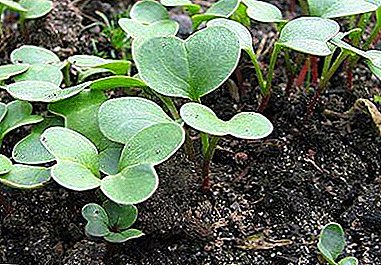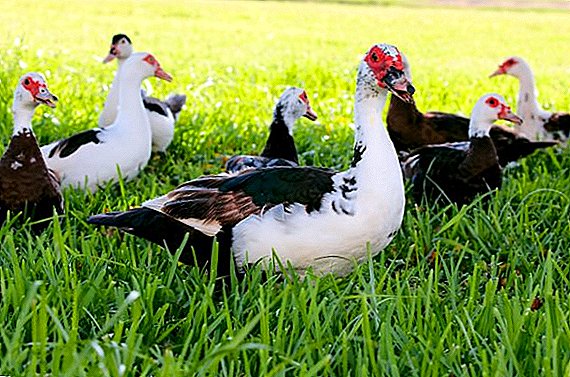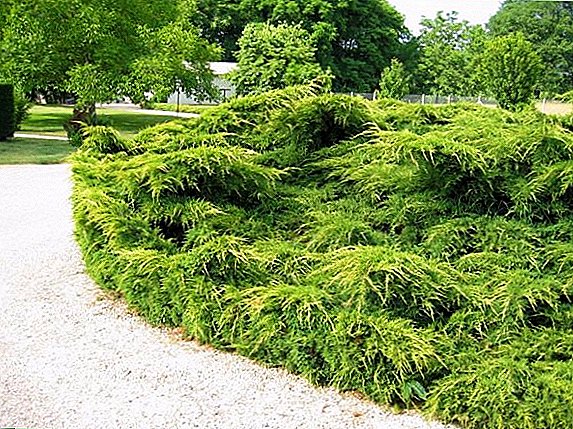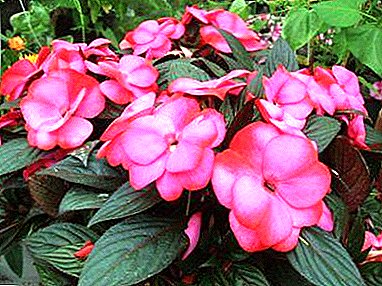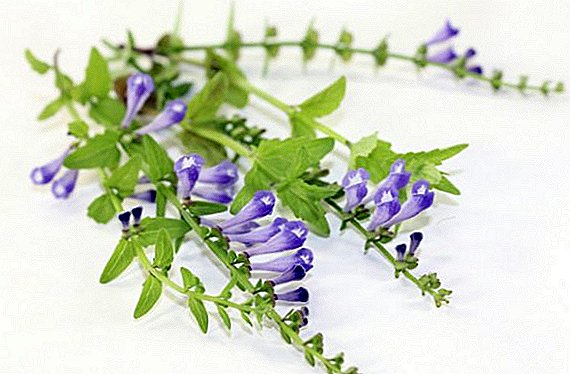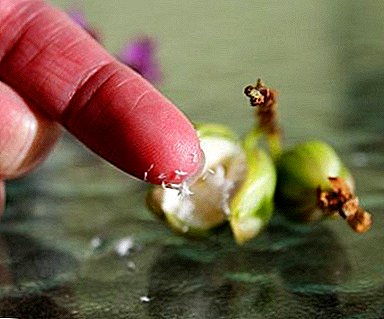 Parsley is one of the favorite herbs of almost every housewife. Seasoning can perfectly complement both meat and vegetable dishes, and fish. However, few people know the beneficial properties of the root of the spicy grass, as well as the healing properties of various means based on it. This article will take a detailed look at how parsley root looks, how it is good for health, and how to cook it correctly.
Parsley is one of the favorite herbs of almost every housewife. Seasoning can perfectly complement both meat and vegetable dishes, and fish. However, few people know the beneficial properties of the root of the spicy grass, as well as the healing properties of various means based on it. This article will take a detailed look at how parsley root looks, how it is good for health, and how to cook it correctly.
Description and chemical composition of parsley root
The root of parsley is commonly understood as the underground part of the plant, aimed at feeding the green mass and stems, as well as the storage of nutrients. This is one of the most fleshy parts of the plant, which consists of special storage cells located in the parenchyma (the so-called special absorbent root tissue). Externally, the root is a rod about 20-30 cm long with numerous small hairs. Its surface is smooth, light yellow in color, with a characteristic specific smell.

The main value for the body is the composition of the root.
| Vitamin composition of parsley root: | The mineral composition of parsley root: |
|
|
Did you know? Parsley root, along with greens, is one of the oldest plants widely used in food and culture. The first mentions of this are found in the most ancient Mediterranean manuscripts dating back to the 4th century BC. er
Nutritional value of parsley roots:
| Substance | Amount (in 100 g) |
| Fatty acid | 0.5 g |
| Ash | 1.4 g |
| Starch | 5 g |
| Saccharides | 6 g |
| Organic acids | 0.1 g |
| Alimentary fiber | 3.3 g |
| Water | 83 g |
| Essential oils | 0.1 g |
Useful properties of parsley root
The main beneficial properties of the root are explained by its structure. During the growing season, the parenchyma accumulates in its composition all kinds of trace elements and further transformed vitamins and other substances.

They have the following therapeutic effects:
- inhibit the multiplication of pathogenic bacteria;
- activate the formation and secretion of bile;
- improve digestion and the work of the digestive tract;
- protect cells from oxidation;
- strengthens blood vessels and capillaries, stimulates the blood supply to organs and tissues;
- heal wounds and have an analgesic effect;
- normalize body temperature;
- with periodic use increase the body's resistance to allergens;
- tone up, and also increase natural immunity of the person.
It is also worth mentioning such substances as myristicin and apiol contained in the essential oils of the plant. They have a strong antispasmodic effect, which helps to eliminate both mild pain and moderate pain. Also, these substances belong to the group of natural antioxidants that can protect cells from the harmful oxidative effects of the environment.
Did you know? In ancient Greece, it was believed that root parsley appeared at the site of the fall of the blood of the gods. That is why the root vegetable used food warriors before the battle (to increase strength, fearlessness and gaining invulnerability).
The use of parsley roots in traditional medicine
The rich composition of parsley root is widely used in traditional medicine. On its basis, they prepare various decoctions, infusions and extracts that can both support the body in a difficult situation and eliminate the manifestations of many, including chronic ailments. However, before using such drugs, it is necessary to get acquainted with the instructions for their use, otherwise they may have an undesirable effect on the body.
With prostate
Over the years, parsley root has been actively used to improve potency and fight prostatitis. It can eliminate pain, as well as relieve inflammation from the affected gland. In addition, due to the powerful impact, it is also possible to improve the blood flow in the problem area, which reduces the effect on the body of stagnant processes. To do this, use fresh roots infused in boiling water for 12 hours. The resulting liquid is taken every day, before eating, 1 tbsp. l

To clean the body
The diuretic and adsorption properties of parsley are actively used to clean the body of toxins. The plant helps to release harmful substances from the organs and tissues, and then instantly remove them. Compliance with this diet provides an opportunity to eliminate excess weight. To do this, fresh chopped root consumed on an empty stomach, 1 time per day, in a tablespoon.
To facilitate PMS
For women, the plant is also indispensable. With moderate use during PMS, the root makes it possible to reduce the characteristic pain, improve mood. However, many do not know how to prepare such a healing tool. To do this, you just need to insist a tablespoon of the root in a glass of boiling water. Use the infusion before each meal, 1 tbsp. l
Important! Folk remedies should be used only after consulting with medical professionals, otherwise there is a high probability of aggravating the course of the underlying ailment.
For the heart system
Due to the increased content of potassium and magnesium, folk remedies based on parsley roots contribute not only to alleviate the manifestations of the underlying disease, but also to improve the functional activity of the heart muscle, as well as reduce puffiness. Used for this infusion of 1 tbsp. l crushed raw materials and a glass of water. The resulting liquid is taken 3 times a day, 150 ml.
Features of the use of parsley roots in other areas
In addition to medical purposes, parsley has long been used in cosmetology and even in cooking. Greens and root are able to improve the condition of the skin, and the nutritional properties of the root are not inferior to the bulk of the roots. However, when using a plant, it is imperative to remember about the high content of all kinds of substances that, when used uncontrolledly, can cause a surplus of minerals harmful to the body. 
In cosmetology
The use of parsley in home cosmetology is based on the principles of traditional medicine. Even as centuries ago, healers actively used the plant to eliminate acne. Today, its use has only expanded its boundaries. Root decoctions are used to eliminate cosmetic problems of the skin associated with scarlet fever, chickenpox and measles. If you regularly drink this tool, you can forget about the problems of acne and age rash.
When used externally, the decoction can help to overcome fungal manifestations, as well as lichen. In addition, fresh root juice is quite actively used in a variety of pathologies that cause skin pigmentation. On its basis, create a variety of masks, able to whiten freckles, age spots and more. Such juice is also quite well manifested for oily skin - it cleanses the pores, improves the complexion, and also has a rejuvenating effect.
Important! Before using externally, a small amount of the substance should be applied to a hidden area of skin. In the case of redness, itching, rash and other symptoms, one can speak of idiosyncrasy, in which such cosmetic substances are strictly prohibited.
With the help of decoctions can be overcome and problems of hair. Such a tool in just a few applications can dramatically reduce the amount of dandruff, as well as normalize the condition of the hair. To do this, apply the so-called rinsing of hair and scalp, after the regular water treatments.
In cooking
Modern cooking is rich in all sorts of recipes, the basis and ideal complement of which is parsley. Dried and fresh root is used to improve the taste of meat, fish and all kinds of vegetable dishes. Most often it is used in a finely chopped form, like a spicy spice, but it can also be fried, boiled and stewed - then the root crop can serve as a side dish for almost any meat dish. It is irreplaceable for making sauces, in this case the root is finely chopped or passed through a blender.

The parsley root nourishes and fresh salads with interesting notes. It is ground together with any set of fresh vegetables, and then the choice is filled with vegetable oil or yogurt. This set is best gives the opportunity to feel the whole flavor of the root, as well as get acquainted with its unique and exotic taste.
How to prepare parsley roots for the winter
Parsley root is not often found in supermarkets, so the majority of root-lovers have a very rational question of where it can be easily taken. If you do not have a summer cottage for the free growing of vegetables, you can buy it at the vegetable markets. In the summer-autumn period, it is massively supplied by both small and large farms.
We advise you to read about the features of the cultivation of root parsley.
The period of distribution of fresh root vegetables lasts only a few months, so the extension of its shelf life is an important and necessary requirement. Most often it is stored in its entirety, in a cellar or basement. The place should be dry, well ventilated, with a temperature of about + 15 ° C. For laying in the vegetable storehouse, the root crop is placed in shallow plastic or wooden boxes, and then in one layer is covered with clean river sand.
You can also root and freeze. To do this, it is thoroughly cleaned, and then passed through a meat grinder or rubbed on a small grater. Then it is portioned packed into plastic bags and placed in a freezer at -20 ° C. If necessary, the roots can be left whole or cut into circles, straws, etc.

In the case of a small freezer, the grated root can be dried. The ideal option for this would be a special dryer for vegetables, but it is also possible to dry the vegetable in an ordinary oven. To do this, it is placed on a baking sheet, in one layer, and subjected to prolonged heat treatment at a temperature not higher than + 40 ° C. The resulting billet is placed in paper bags and stored in a dry, well-ventilated place.
What can replace parsley root
In home medicine, it is not recommended to make any drastic changes to the ingredients of various means, but during the off-season this is a necessary requirement. Parsley root is considered a rare root vegetable, so the question of how to replace it is given by many herbalists.
Important! It is necessary to brew and insist preparations from parsnip and celery solely according to the appropriate recipes, developed taking into account all the characteristics of each individual plant. It is inappropriate to apply the technology of processing parsley root.
Its main alternative is parsnip. This plant is a member of the Umbrella family, which includes parsley; Thus, parsnip is a related species, with many qualities inherent in parsley. By the same kind of relatives, can be attributed, and loved by many celery. In addition to the common origin, the plant has a number of advantages, which, above all, include the high nutritional properties of its rhizomes.

Contraindications
Using daily decoctions, alcohol tincture and other means based on the root of parsley, you can perfectly maintain health and gain strong immunity against many diseases. But in some cases, such therapy may be harmful to health.
To prevent this, the root vegetable is not recommended when:
- pregnancy and lactation;
- individual intolerance to the individual components of the vegetable;
- any allergies;
- pathologies of the kidneys, including in the case of glomerulonephritis and nephritis;
- epilepsy;
- exacerbation of gastritis and peptic ulcer.

Parsley root is a no less valuable part of the plant than spicy greens. Its composition contains many useful and important for health substances, which are often absent in green mass. But, despite its enormous health benefits, home-based root-based products should be used exclusively after consulting with doctors, otherwise a valuable plant can cause significant health damage.


